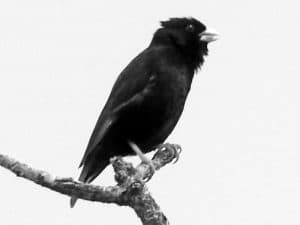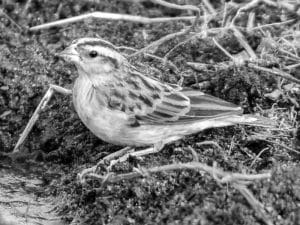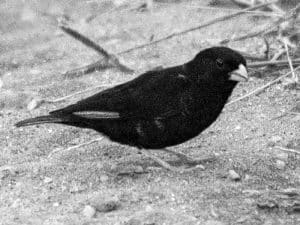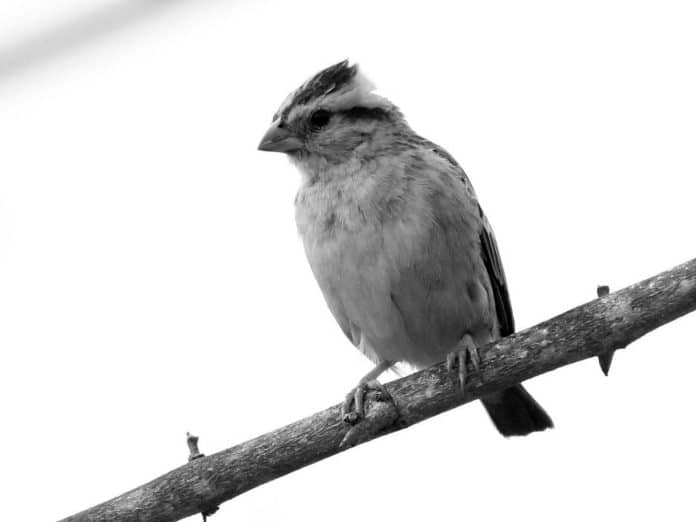Introduction to the Purple Indigobird
The Purple Indigobird in Tanzania, scientifically known as Vidua purpurascens, is a small, finch-like bird that is native to the grasslands and savannas of Tanzania. With its striking plumage, captivating song, and unique breeding habits, the Purple Indigobird has captured the attention of naturalists and birdwatchers from around the world.

As a member of the Indigobird family, the Purple Indigobird is known for its remarkable ability to mimic the songs of other bird species, a behavior that plays a crucial role in its mating rituals and social interactions. This fascinating adaptation has made the Purple Indigobird a subject of intense study and fascination among ornithologists and wildlife enthusiasts alike.
Habitat and Distribution of the Purple Indigobird in Tanzania
The Purple Indigobird is primarily found in the grasslands, savannas, and open woodlands of Tanzania, with its range extending across the central and northern regions of the country. These birds thrive in areas with a mix of tall grasses, scattered trees, and access to water sources, such as streams, ponds, and wetlands.
One of the key factors that contribute to the Purple Indigobird’s habitat preferences is the presence of its host species, the Firefinch. As a brood parasite, the Purple Indigobird relies on the Firefinch to raise its young, with the female Indigobird laying her eggs in the Firefinch’s nest. This symbiotic relationship has shaped the Purple Indigobird’s distribution, as it is often found in close proximity to Firefinch populations.
To better understand the Purple Indigobird’s habitat and distribution in Tanzania, consider the following:
- Grasslands and Savannas: The Purple Indigobird thrives in the vast grasslands and savannas that cover much of central and northern Tanzania, where it can find ample food sources and nesting opportunities.
- Open Woodlands: These birds are also found in areas with a mix of grassy patches and scattered trees, which provide the ideal combination of cover, perching sites, and access to water.
- Proximity to Firefinch Populations: As a brood parasite, the Purple Indigobird is often found in close association with Firefinch populations, as the Firefinch’s nests serve as the primary host for the Indigobird’s offspring.
- Elevation and Climate: The Purple Indigobird is typically found at lower to mid-elevations, where the climate is warm and relatively dry, with distinct wet and dry seasons.
By understanding the specific habitat requirements and distribution patterns of the Purple Indigobird in Tanzania, you can increase your chances of spotting this captivating bird during your wildlife adventures.
Physical Characteristics of the Purple Indigobird
The Purple Indigobird is a small, finch-like bird with a distinctive plumage that sets it apart from its avian counterparts. The male Indigobird is the one that truly captivates the eye, with its vibrant, iridescent purple feathers that shimmer and glisten in the sunlight.
To get a closer look at the physical features of the Purple Indigobird, consider the following:
- Size and Appearance: The Purple Indigobird is a relatively small bird, measuring approximately 12-14 centimeters (4.7-5.5 inches) in length and weighing around 15-20 grams (0.5-0.7 ounces). Its compact, slender build and short, conical beak are characteristic of the Indigobird family.
- Plumage: As mentioned, the male Purple Indigobird is the true showstopper, with its stunning iridescent purple feathers that can appear to shift in color from deep indigo to vibrant violet, depending on the angle of the light. The female, on the other hand, is more subdued in appearance, with a brown or grayish-brown plumage that helps her blend in with her surroundings.
- Eyes and Beak: The Purple Indigobird has large, dark eyes that are accentuated by a small, sharp beak, which it uses for foraging and feeding. The beak’s conical shape is well-suited for cracking open seeds and other small food items.
- Legs and Feet: These birds have slender, delicate legs and feet, which are adapted for perching and hopping among the grasses and shrubs of their preferred habitat.
The striking appearance of the male Purple Indigobird, with its shimmering purple plumage, is a sight that is sure to captivate and delight any birdwatcher or nature enthusiast lucky enough to catch a glimpse of this remarkable species.
Breeding Behavior and Mating Rituals of the Purple Indigobird
The breeding behavior and mating rituals of the Purple Indigobird are truly fascinating, as they showcase the bird’s remarkable adaptations and social interactions. As a brood parasite, the Purple Indigobird relies on the Firefinch to raise its young, and its mating strategy reflects this unique relationship.
To better understand the breeding and mating behaviors of the Purple Indigobird, consider the following:
- Mimicry and Courtship: During the breeding season, male Purple Indigobirds engage in an intricate courtship display, which involves the mimicry of other bird species’ songs. By imitating the calls of their host species, the Firefinch, the male Indigobird is able to attract a female and signal his readiness to mate.
- Nest Parasitism: Once a female Indigobird has been attracted, she will seek out a Firefinch nest and lay her own eggs among the Firefinch’s clutch. The Firefinch, unaware of the deception, will then proceed to incubate and raise the Indigobird’s offspring as if they were its own.
- Parental Care: The Firefinch parents, oblivious to the fact that they are caring for a parasitic species, will provide food and protection for the Indigobird chicks, ensuring their survival and successful fledging.
- Brood Parasitism Adaptations: The Purple Indigobird has evolved several adaptations to ensure the success of its brood parasitism strategy, including the ability to mimic the Firefinch’s calls and the production of eggs that closely resemble those of its host species.
- Breeding Seasons: In Tanzania, the Purple Indigobird’s breeding season typically coincides with the rainy season, when food sources are abundant and the Firefinch’s nesting activity is at its peak.
By understanding the complex and fascinating breeding behaviors of the Purple Indigobird, you can gain a deeper appreciation for the intricate web of relationships that exist within the natural world.
Diet and Feeding Habits of the Purple Indigobird
The Purple Indigobird is an omnivorous species, with a diet that consists of a variety of seeds, insects, and other small invertebrates. Its foraging behavior and feeding habits are well-suited to the grasslands and savannas it calls home.
To learn more about the Purple Indigobird’s dietary preferences and feeding habits, consider the following:
- Seed-Eating: As a member of the finch family, the Purple Indigobird is primarily a seed-eater, consuming a wide range of grass and weed seeds found in its grassland and savanna habitats.
- Insect Consumption: In addition to seeds, the Purple Indigobird also supplements its diet with various insects, such as grasshoppers, beetles, and caterpillars, which it forages for among the grasses and shrubs.
- Foraging Behavior: These birds are typically seen hopping and flitting among the vegetation, using their sharp beaks to extract seeds and insects from their hiding places. They may also occasionally venture to the ground to forage for food.
- Seasonal Shifts: The Purple Indigobird’s diet may shift slightly throughout the year, with a greater emphasis on insects during the rainy season when they are more abundant, and a focus on seeds during the drier months.
- Feeding Adaptations: The Purple Indigobird’s conical beak is well-suited for cracking open seeds and capturing small insects, allowing it to thrive in its grassland and savanna habitats.
By understanding the dietary preferences and feeding habits of the Purple Indigobird, you can gain valuable insights into the bird’s role within the broader ecosystem of Tanzania’s grasslands and savannas.
Conservation Status and Threats to the Purple Indigobird

The Purple Indigobird is currently classified as a species of “Least Concern” by the International Union for Conservation of Nature (IUCN), indicating that its overall population is stable and not facing immediate threats of extinction. However, like many other bird species, the Purple Indigobird does face a number of potential threats that could impact its long-term survival.
Some of the key conservation concerns and threats facing the Purple Indigobird include:
- Habitat Loss and Degradation: The conversion of grasslands and savannas into agricultural land, urban development, and other human activities can lead to the loss and fragmentation of the Purple Indigobird’s preferred habitat.
- Overgrazing: Excessive grazing by livestock can degrade the quality of the Purple Indigobird’s habitat, reducing the availability of suitable nesting sites and food sources.
- Pesticide Use: The use of pesticides in agricultural areas can have negative impacts on the Purple Indigobird’s food sources, potentially leading to declines in its population.
- Brood Parasitism Disruption: Changes in the populations or breeding patterns of the Firefinch, the Purple Indigobird’s host species, could disrupt the Indigobird’s own breeding and reproductive success.
- Climate Change: Shifts in temperature, precipitation, and other climatic factors could potentially alter the Purple Indigobird’s habitat and food availability, posing a long-term threat to the species.
To ensure the continued conservation of the Purple Indigobird in Tanzania, it is essential that efforts are made to protect and preserve its grassland and savanna habitats, as well as to monitor and address any potential threats that may arise. By working to safeguard this remarkable bird, we can help to ensure that future generations will be able to marvel at its stunning beauty and unique behaviors.
Tips for Spotting the Purple Indigobird in Tanzania
Seeing the Purple Indigobird in its natural habitat is a true delight for birdwatchers and nature enthusiasts visiting Tanzania. While these birds may not be as easily spotted as some of the country’s more well-known wildlife, there are several tips and strategies that can increase your chances of catching a glimpse of this captivating species.
- Timing and Seasonality: The best time to spot the Purple Indigobird is during the breeding season, which typically coincides with the rainy season in Tanzania. During this time, the males are more vocal and actively displaying, making them easier to locate.
- Habitat Identification: Focus your search on areas of grasslands, savannas, and open woodlands, as these are the primary habitats where the Purple Indigobird can be found. Pay close attention to the presence of Firefinch populations, as the Indigobird is often found in close association with its host species.
- Listening for Vocalizations: The Purple Indigobird’s distinctive, melodic song is one of the best ways to locate these birds. Listen for a series of high-pitched, whistling notes that may be interspersed with mimicry of other bird species.
- Binoculars and Patience: Bring a good pair of binoculars to help you spot the Purple Indigobird’s small, inconspicuous form among the vegetation. Be prepared to spend time patiently scanning the area, as these birds can be elusive and easily overlooked.
- Join a Guided Tour: Consider joining a birdwatching or wildlife tour led by a knowledgeable local guide, who can help you navigate the best locations and increase your chances of spotting the Purple Indigobird.
By following these tips and being mindful of the Purple Indigobird’s habitat preferences and behaviors, you can increase your chances of witnessing the stunning sight of this remarkable bird in its natural environment.
Other Bird Species Found in the Same Habitat as the Purple Indigobird
While the Purple Indigobird is undoubtedly the star of the show, the grasslands and savannas of Tanzania are home to a diverse array of other bird species that share the same habitat. By familiarizing yourself with some of these avian companions, you can enhance your overall birdwatching experience and gain a deeper appreciation for the rich avian diversity of this region.
Some of the other bird species you may encounter in the same habitat as the Purple Indigobird include:
- Firefinch: As the host species for the Purple Indigobird, the Firefinch is a common sight in the same grassland and savanna environments.
- Weavers: Various species of weavers, such as the Village Weaver and the Red-billed Quelea, are often found in the same areas as the Purple Indigobird, building their intricate nests among the vegetation.
- Larks: Ground-dwelling species like the Rufous-naped Lark and the Flappet Lark are well-adapted to the open, grassy habitats preferred by the Purple Indigobird.
- Cisticolas: These small, inconspicuous birds, such as the Rattling Cisticola and the Zitting Cisticola, can be spotted flitting among the grasses and shrubs.
- Sunbirds: Colorful, nectar-feeding birds like the Amethyst Sunbird and the Scarlet-chested Sunbird may be seen visiting the flowering plants in the same areas.
By familiarizing yourself with the diverse array of bird species that share the habitat with the Purple Indigobird, you can enhance your overall birdwatching experience and gain a deeper understanding of the rich avian community that thrives in Tanzania’s grasslands and savannas.
Unique Facts and Interesting Trivia about the Purple Indigobird

The Purple Indigobird is a truly remarkable bird species, with a host of unique characteristics and fascinating behaviors that set it apart from its avian counterparts. As you explore the world of the Purple Indigobird, consider the following interesting facts and trivia:
- Brood Parasitism: As a brood parasite, the Purple Indigobird is one of the few bird species that does not build its own nest or care for its own young. Instead, it relies on the Firefinch to raise its offspring, a strategy that has evolved over countless generations.
- Mimicry Abilities: The Purple Indigobird’s ability to mimic the songs of other bird species, particularly its host, the Firefinch, is truly remarkable. This skill is crucial for the Indigobird’s mating and breeding success.
- Iridescent Plumage: The male Purple Indigobird’s striking iridescent plumage is the result of the unique structure of its feathers, which reflect light in a way that creates the shimmering, shifting hues.
- Symbiotic Relationship: The interdependent relationship between the Purple Indigobird and the Firefinch is a prime example of the intricate web of connections that exist within natural ecosystems.
- Evolutionary Adaptations: The Purple Indigobird’s brood parasitism and mimicry abilities are the result of a long evolutionary process, shaped by the pressures of survival and the need to ensure the successful propagation of the species.
- Significance in Local Cultures: In some regions of Tanzania, the Purple Indigobird has cultural significance, with its appearance or song being associated with certain beliefs or traditions.
By exploring these unique facts and fascinating trivia about the Purple Indigobird, you can gain a deeper appreciation for the wonder and complexity of this remarkable avian species, and the role it plays within the broader tapestry of Tanzania’s natural world.
Conclusion: Why the Purple Indigobird is a Fascinating Sight to Behold in Tanzania
The Purple Indigobird is a true marvel of nature, a captivating species that embodies the incredible diversity and wonder of Tanzania’s avian world. From its striking iridescent plumage to its remarkable brood parasitism and mimicry abilities, this small finch-like bird has captured the hearts and imaginations of birdwatchers and nature enthusiasts alike.
As you venture into the grasslands and savannas of Tanzania, keep your eyes and ears open for the shimmering purple hues and melodic calls of the Purple Indigobird. Its presence is a testament to the resilience and adaptability of life in this remarkable East African nation, and a reminder of the endless fascination that can be found in the natural world.
Don’t miss your chance to witness the captivating beauty of the Purple Indigobird during your next visit to Tanzania. Plan your wildlife adventure today and immerse yourself in the enchanting world of this remarkable bird species.

































